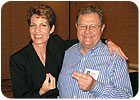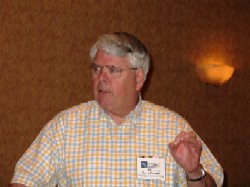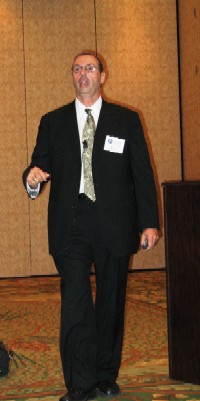

A series of one-hour programs were fitted in between a couple of two-hour programs of particular interest. Leading off and keynoting the session was Ricardo González, founder and CEO of Bilingual America, who informed the audience how to deal with our nation's increasingly Hispanic labor force.
One key to understanding them is to first understand that “there is no such thing as a Hispanic,” explains González, who prefers the term “Latino.” The term “Hispanic” derives from political strategizing during the Nixon administration, which viewed Spanish-speaking Americans as a voting bloc to be cultivated. In reality, there are 22 Latin American countries, each with its cultural distinctions and sometimes animosities toward one another. Latinos are united by language and share a similar set of family-based values; however, they tend to be intensely nationalistic about their country of origin.
A major premise of González' presentation was the mistake made by many American employers of appointing Latinos to supervise Latinos on the basis of language alone. Employers fail to understand that the primary loyalty of such supervisors will be to the employees working for them, rather than the company. He also stunned many in the audience with results of a survey taken by his organization showing that most Latino workers would prefer to be supervised by an American rather than a fellow Latino.
Other points made by González include:
• Latinos represent 45 percent of the population growth in the United States over the past 10 years. By 2050, 35 percent to 40 percent of the U.S. population will be Latino.
• If you bring someone into your organization, it is your responsibility to communicate with that person. That means, if you knowingly hire someone who cannot speak English, you are obligated to learn some of that person's language in order to communicate company policies, such as work hours and safety regulations.
• No construction company should have turnover above 10 percent. If you have high turnover, most likely your Latino employees do not trust you. To gain their trust, do what you say you will do.
• It is not in your best interest to have everyone in your company related to each other. Do not recruit Latinos through family and friends or through newspapers. Do not pick up workers from a day labor organization. Instead, recruit in schools, churches and social organizations.
• If you know you need eight people in labor, hire one or two people with the ability and qualifications to lead; these will be your future supervisors and foremen.
• Job skill training for Latino workers should be visual. Print out photos from OSHA; don't just translate the English text into Spanish. Leverage the Latinos' love of family when teaching safety.

Women Take The Stage
Another highlight of the conference was a “Women in Plumbing” panel featuring prominent women from various segments of the plumbing industry discussing the opportunities and obstacles presented to their gender in a male-dominated industry, and how to overcome the latter.The moderator was Ellen Rohr, a consultant and popular small business columnist with Plumbing & Mechanical magazine, as well as the former president of Benjamin Franklin Plumbing. There was a large percentage of industry women in the audience, so there were a lot of questions for the panelists.
Jo Rae Wagner of CTO Inc. (and PHCC-NA president-elect) started the session recounting her early days as an estimator in the plumbing contracting business with her father. When he retired, he turned all his stock over to her. She began to run the company after her husband had a heart attack.
There was some fallout from her Latino workers with her being “the boss,” but they accepted her once she proved she had paid her dues and cared about the people in the field.
To attract women to the industry, Wagner says let them know that not all the jobs involve getting into the grime and muck. The industry is short of estimators and project managers, HR people and middle management, and Wagner says these positions could be filled by women, since they are good with detail and very articulate.
And with the shortage in technicians, the industry could be marketing itself to single moms who may be in low-paying secretarial or waitressing jobs. “Plumbing is cleaner than raising kids,” she quipps.
“We have an opportunity to make a difference in women's lives, let them know the construction industry is a place where women are not only needed but wanted,” she adds. “It has been a good life for me, and would be a wonderful occupation for any woman.”
Dottie Ramsey began her plumbing career 41 years ago when she started as a billing clerk at Modern Supply. The founder of the company saw potential in her and became her mentor. She moved up the ranks and is now president and chief operating officer of the company. In the late 1980s she became the first female president of the Southern Wholesalers Association.
Her company employs 99 people, 25 of which are women (including a woman counter salesperson). She informed the audience that her best warehouse manager was female, running a 100,000-sq.-ft. facility. “I tell every female employee she doesn't have to act like man,” Ramsey adds.
Next on the roster was Ingrid Mattsson, who, when starting her career at Uponor 11 years ago, “did not know a Btu from a BLT.” Her experience before Uponor was in banking and business. But she learned about radiant heating and plumbing from the people she worked with, and she is now the senior marketing manager at the firm.
She's worked for men and for women (including an ambassador to UNESCO) and has found that women are conscious of their role in business and their interaction with male counterparts. “What men take for granted, women fight for,” she explains.
Mattsson had five tips for attendees: 1) know what your limitations and capabilities are; 2) be yourself; 3) find out what you need to learn to get ahead, then learn it; 4) appreciate the differences between men and women; and 5) take the time to listen.
The bottom line? “Stop thinking of women as women,” she says. “Think of them as professionals.”
The lone licensed plumber on the panel, Jennifer Courchaine's been in the plumbing business for 13 years, doing everything from new construction to septic tanks and wells. She says her mother gave her great advice when she decided to be a plumber: “Have a thick skin and a good attitude.”
Her father helped her get her first job because no one would hire her. It was a three-month trial, but lasted for three years. She had other problems because of her gender - doors slammed in her face by male customers, not hired for a job, even fired.
“Everyone has reservations about hiring women and being sued,” she says. “Harassment issues, strength issues, child care issues. But look at the men you are hiring. Are their issues more important than mine? They have family obligations; they may also have strength issues.”
She believes women plumbers displace the stereotype of the plumber. She shows up on time. She's clean and professional-looking. She explains how the heating system works or how to shut off the water. She doesn't leave a mess in a customer's home.
Courchaine is requested 10 times more than the male plumbers at The Winters Co.

Succession of the company was not a priority, and it usually came through tragedy. Her grandfather died at age 56, and her parents and uncle were forced to take over the company. Her uncle also died at age 56, and when her mother died a few years ago, Lewis was the only family member left in the company. She is now the chairman.
At the time of her mother's death, company finances were not good, and Lewis had to make a tough choice: Try to turn Gerber around, or find a buyer. She chose to find a buyer, and it has given the company a chance to grow and prosper.
Lewis says that mentoring is very important. She didn't have that when she started in the business, but it is very much a part of her company now. “There are a number of young women in our business,” she says, “and they are respected by everyone. They have the opportunity to become more than they might have become 15 to 20 years ago.”
She adds: “My hope, as years go on, is that there will be less reason for a panel like this.”

Experts Galore
“Innovative Thinking 2006” featured 10 other speakers with particular expertise in the hiring-retention-training topic - consultant Jesse Elliott talked about the cost of turnover; PM columnist Paul Ridilla gave tips on hiring and retention; Mike Mayberry, president of HVAC Agent and Plumbing Agent, expanded on his seven recruiting tips; Megan White, director of organizational development at Castle Supply, discussed her emerging leader program; Dr. Lesley Pagliari, assistant professor at East Carolina University, explained her efforts in recruiting young workers in distribution.


Jesse Elliott: “The Cost of Turnover”
• Obvious costs of hiring are the tip of the iceberg. Larger costs come from lost knowledge and expertise, lost continuity and time, and lost opportunity.• “Up to speed” time for replacements depends on the level and complexity of the job. Divide the person's salary by $10,000, and you'll get the approximate “up to speed” time in months.
• Clearly, outstanding performers in critical jobs demand more time and attention than others to prevent them from leaving. Look for signs of dissatisfaction before things come to a head, and start the conversation before it's too late.
• If someone outstanding does leave, call that person in three to six months to see how things are going. There's a chance the other job didn't work out and you might be able to get the person back.
• Money is a major dissatisfier, but rarely a satisfier. Sometimes people making the most money are quicker to leave for short-term opportunities to make a few more bucks.
• Retention is an open-ended problem that is never solved. Treat your people like they are important - because they are. Don't get tired of doing this.

William Raymond: “The Power of People”
• What is unique about your company is your people. Accept that your employees are your greatest competitive asset. They create your customer's experience.• Understand what your employees really want. Commit to being a people-development company.
• Commit yourself to developing your leadership and management skills.
• To train and develop your people: get them involved in decisions; hold a job fair; push them safely and challenge them constantly; post the company's goals and values; read trade magazines; send your people to trade shows and events like the “Innovative Thinking” conference; offer a mentoring program; be inclusive; host weekly training meetings with the reps; perform honest performance evaluations.
• Our biggest challenge is to know our cost of doing business and charge customers the right price.
• Decide who you want to BE. After you are clear on that, DO, HAVE and GIVE BACK.
• Choose what is important, recognize your fears and get through “Fear Junction.”

Mike Mayberry: “Recruiting 101”
• Look at recruiting like the courtship process. You want your employees to feel their quality of life is better with your company than it would be working for your competitor.• The average service tech will generate about $100,000 a year. At a 30 percent gross profit margin, the service tech will bring about $30,000 in gross profits to your organization. Base your recruiting budget on projected return on investment.
• Of 100 employees in your area in the plumbing trade, 53 will be plumbers, service or install. If 10 percent change jobs every year, only five of them will change jobs in a year. If there are 10 companies in your area, and five of them need to hire plumbers, will you consider recruiting from outside your local area?
• If recruiting from outside your local area, you can learn over the phone 90 percent of what you need to know to make a decision.
• Don't be afraid to do background checks and drug testing. You will eliminate 53 percent of job applicants. Find out if the candidate has any significant others or personal ties to the area.
• Don't pay relocation costs up front. Sign an agreement that you will reimburse an employee up to a particular amount for moving expenses within a certain period of time. Reimburse 30 days after he or she starts the job; put the money in his or her paycheck. Include in the agreement that if the employee quits within 12 months, he or she has to pay back a pro-rated portion of the relocation budget.

Al Levi: “Staffing Power!”
• In order to run your business, you need to have effective technicians and counter salespeople. Train existing staff to be more effective, find new staff and train them effectively.• Hire on attitude, not skills. Once you stop fixating on finding people with the “right” skill set, you can widen your scope of potential recruits.
• Always be in the recruiting process. If you are proactive instead of reactive, you have a better choice of candidates. Desperation does not result in the right people in your company.
• Your employees need to believe they have a career with you, not just a job. If they don't see a future with your company, they will leave.
• Have a training checklist for new hires so they know exactly what they need to know to perform their jobs. Have them sign the checklist.
• Implement ongoing training programs to move your employees up to the next level.